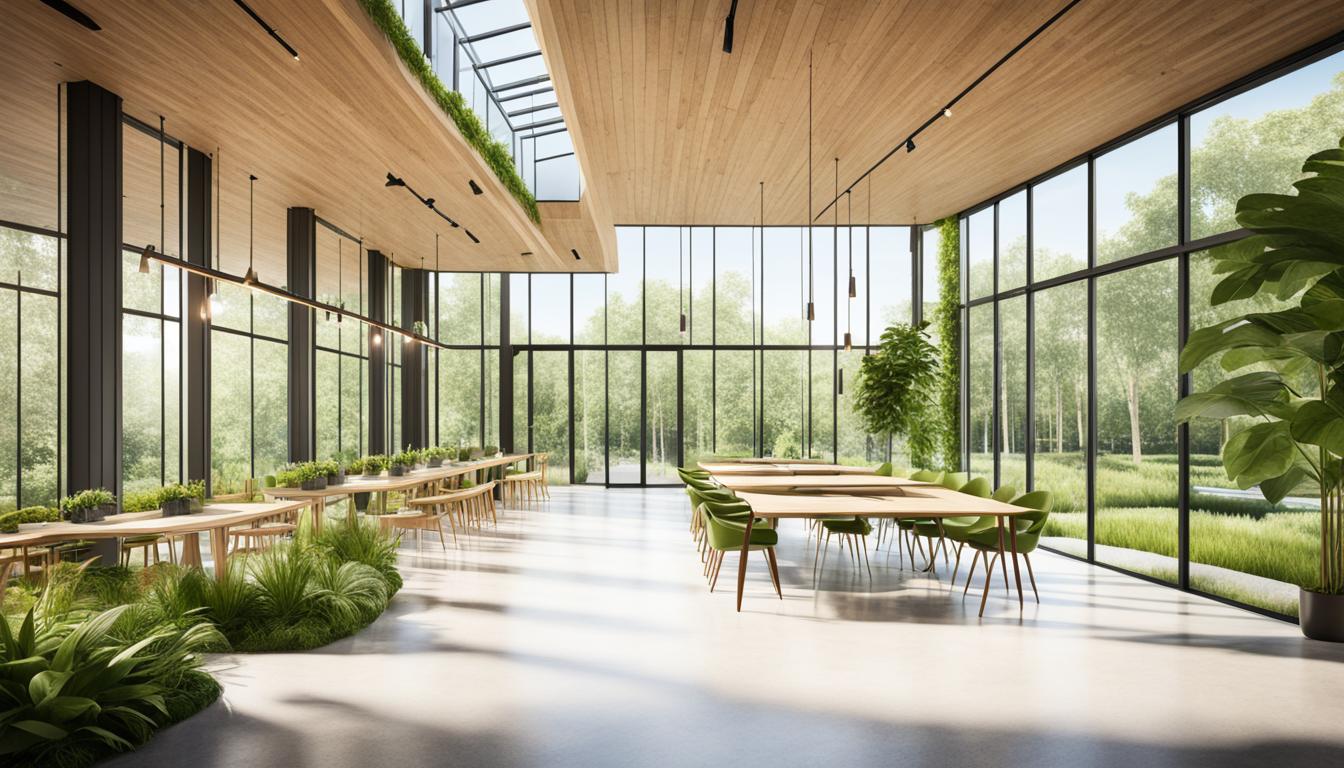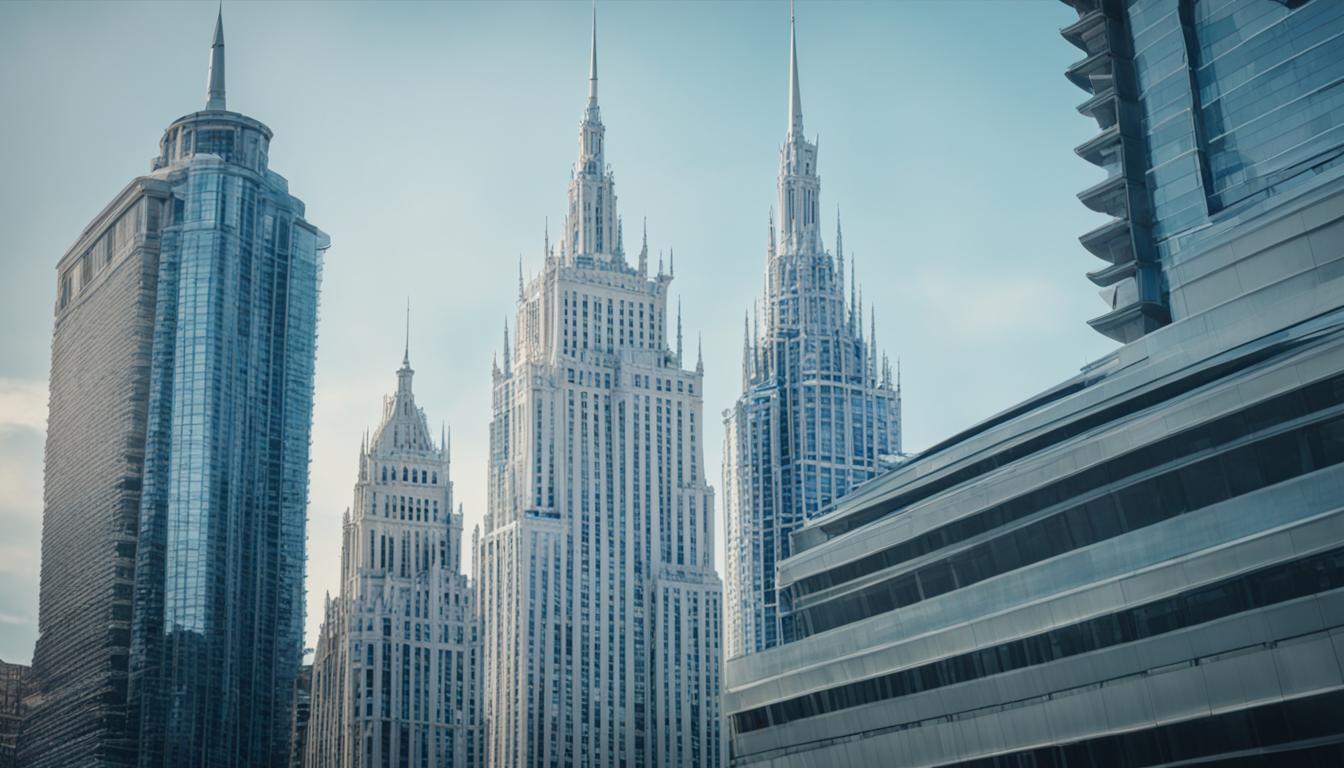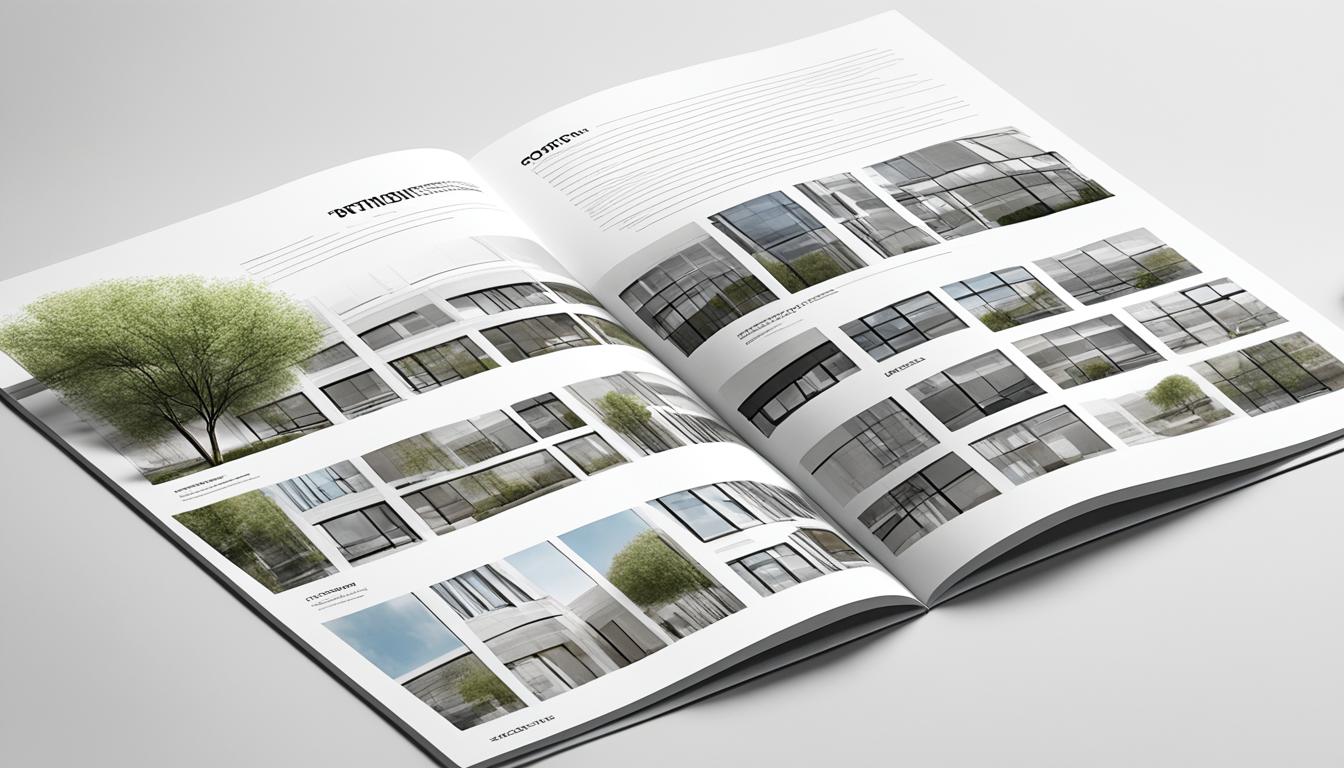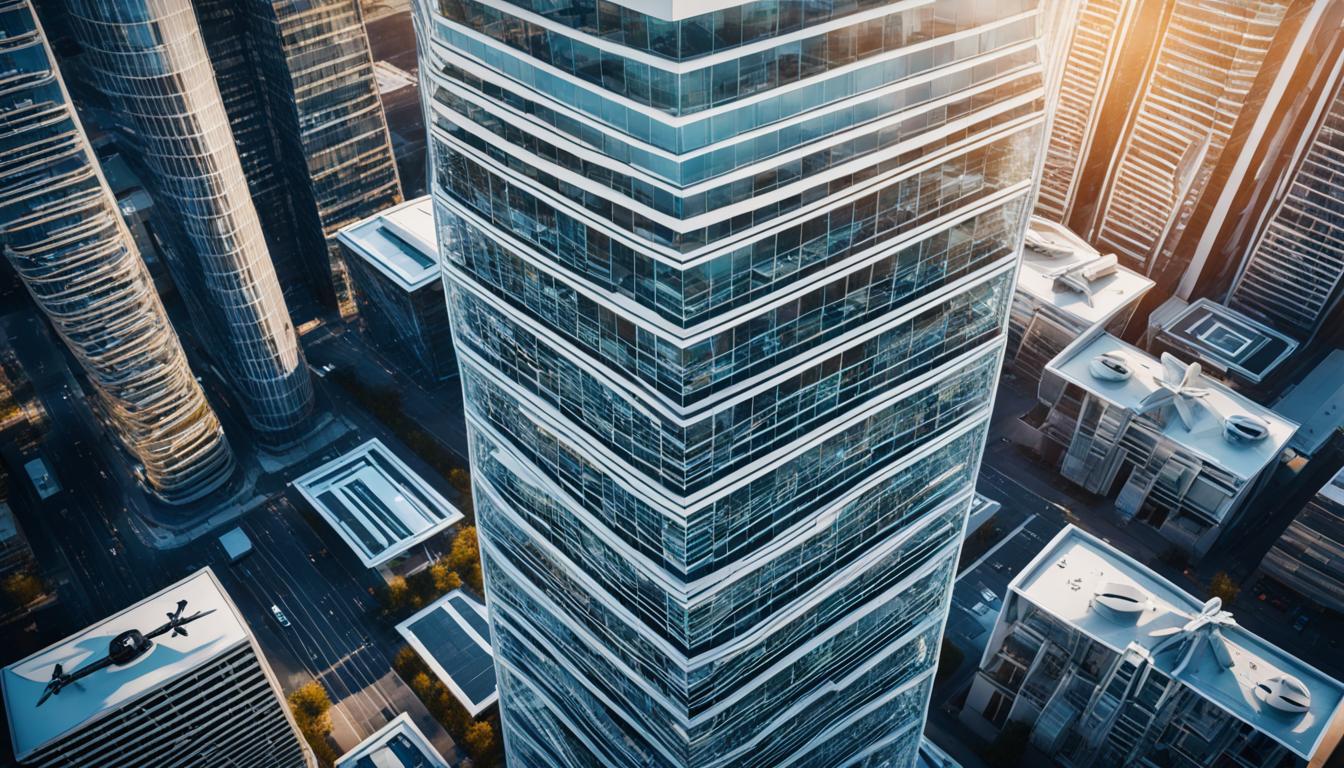Welcome to our guide on eco-friendly architectural photography! In this section, we will explore the importance of environmental considerations in architectural photography and provide tips and techniques for conducting eco-friendly photoshoots. Whether you are a professional photographer or an architecture enthusiast with a camera, it is essential to understand how your photography practices can align with sustainable principles.
Architectural photography allows us to capture the beauty and intricacy of our built environment. However, it’s crucial to be mindful of the environmental impact of our photography process. By adopting eco-friendly photography techniques, we can minimize our carbon footprint and contribute to a greener future.
When photographing sustainable architecture, consider incorporating elements that highlight the environmentally conscious design of the building. Pay attention to how the structure interacts with its surroundings and capture the innovative features that contribute to sustainability.
Furthermore, practicing sustainable design photo composition can create visually appealing images while conveying a message of eco-consciousness. Experiment with angles, lighting, and composition to showcase the building’s sustainable features in the most compelling way.
Lastly, maintain environmentally friendly photoshoot practices throughout your entire process. This includes minimizing energy usage, reducing waste, and utilizing eco-friendly equipment and materials. By being mindful of these practices, you can ensure that your architectural photography aligns with sustainable principles.
Key Takeaways
- Environmental considerations play a vital role in architectural photography.
- Highlight the sustainable features of the building in your photographs.
- Experiment with composition techniques to convey a message of eco-consciousness.
- Minimize energy usage and waste during your photoshoots.
- Opt for eco-friendly equipment and materials whenever possible.
The Environmental Impact of Construction
Construction projects have long been associated with significant environmental consequences, including resource depletion, pollution, and waste generation. The environmental impact of construction is a pressing issue that requires immediate attention. We must embrace sustainable construction practices to mitigate these concerns and ensure a greener future.
One of the main environmental challenges posed by construction is the depletion of natural resources. From the extraction of raw materials to their transportation and processing, construction consumes vast amounts of energy and contributes to resource scarcity. Additionally, construction activities often release pollutants into the air, water, and soil, causing pollution and adversely affecting ecosystems.
It is crucial to recognize that our current construction practices are not sustainable. They lead to resource depletion, pollution, and waste generation, which in turn harm the environment and contribute to climate change. We can no longer afford to ignore the environmental consequences of construction.
Furthermore, construction projects generate massive amounts of waste, including construction debris, packaging materials, and demolition waste. Without proper management, this waste ends up in landfills, further exacerbating environmental issues.
However, there is hope. Sustainable construction practices offer viable solutions to mitigate the environmental impact of construction. By adopting sustainable alternatives, such as utilizing recycled and locally sourced materials, implementing energy-efficient designs, and optimizing construction processes, we can reduce resource consumption, minimize pollution, and decrease waste generation.
Benefits of Sustainable Construction Practices:
- Reduced resource depletion
- Lower pollution levels
- Minimized waste generation
- Improved energy efficiency
- Enhanced environmental preservation
We have the power to shape the future of construction and make it more sustainable. By embracing eco-friendly practices and prioritizing the environmental impact of construction, we can create a built environment that aligns with the principles of sustainability.
| Environmental Consequence | Sustainable Construction Solution |
|---|---|
| Resource Depletion | Utilizing recycled materials |
| Pollution | Implementing energy-efficient designs |
| Waste Generation | Optimizing construction processes to minimize waste |
The Rise of Sustainable Construction
Sustainable construction practices have gained significant traction in recent years as an approach to minimize the negative environmental consequences of building projects. With a growing concern for environmental preservation, architects, engineers, and builders have embraced sustainable construction techniques that prioritize the use of green materials, energy efficiency, water conservation, and waste management.
The adoption of sustainable construction not only reduces the environmental impact but also contributes to creating a greener future. By integrating eco-friendly principles into the construction process, we can build structures that are not only aesthetically pleasing but also align with sustainable development goals.
The Use of Green Materials
One key aspect of sustainable construction is the use of green materials. These materials are carefully selected based on their environmentally friendly attributes, such as low carbon footprint, renewable sourcing, and recyclability. By incorporating green materials like bamboo, recycled steel, and reclaimed wood, construction projects can significantly reduce their ecological footprint and promote resource conservation.
Energy Efficiency in Design
Innovative designs that prioritize energy efficiency play a crucial role in sustainable construction. By utilizing passive solar design, proper insulation, and energy-efficient HVAC systems, buildings can minimize energy consumption and reduce greenhouse gas emissions. Energy-efficient designs not only contribute to environmental preservation but also lead to long-term cost savings for building owners and occupants.
Water Conservation Strategies
Water scarcity is a pressing global issue, and sustainable construction aims to address this challenge through water conservation strategies. By implementing technologies like rainwater harvesting, graywater recycling, and efficient irrigation systems, construction projects can reduce water consumption and minimize pressure on existing water resources. Water conservation not only helps protect the environment but also promotes responsible water management practices.
Waste Management Practices
Effective waste management is a critical component of sustainable construction. Construction projects generate a significant amount of waste, including construction debris, packaging materials, and demolished structures. Sustainable construction practices focus on reducing waste generation, reusing materials whenever possible, and implementing proper recycling and disposal methods. By integrating waste management practices into construction projects, we can minimize the environmental impact and promote a circular economy.

In the next section, we will explore the role of technology in sustainable construction, highlighting the innovative tools and techniques that enhance eco-friendly practices.
The Role of Technology in Sustainable Construction
Technology plays a crucial role in driving sustainable practices within the construction industry. As construction projects aim to minimize their environmental impact and adopt eco-friendly practices, innovative technologies have emerged as powerful tools to achieve these goals.
Building Information Modeling (BIM) is one such technology that has revolutionized the construction industry. BIM allows architects, engineers, and contractors to create virtual 3D models of buildings, enabling efficient collaboration, accurate cost estimation, and better project management. This technology not only improves the accuracy and speed of construction processes but also enables stakeholders to optimize resource usage and reduce waste.
Drones are another technology transforming sustainable construction practices. These unmanned aerial vehicles can capture high-resolution images and videos of construction sites, providing valuable data for visual inspections, progress tracking, and site analysis. Drones enable construction professionals to monitor projects remotely, minimizing the need for excessive physical presence and reducing transportation-related carbon emissions.
Green building certifications, such as LEED (Leadership in Energy and Environmental Design) and BREEAM (Building Research Establishment Environmental Assessment Method), have also played a significant role in driving sustainable construction. These certifications assess and recognize buildings that meet specific sustainability criteria, promoting the use of green materials, energy-efficient designs, and environmentally friendly practices.
The Internet of Things (IoT) is revolutionizing the way we manage and optimize building operations. IoT devices connected to construction projects can collect real-time data on energy consumption, water usage, and indoor environmental quality. This data allows stakeholders to identify areas of inefficiency and implement targeted improvements, leading to significant energy savings and enhanced occupant comfort.
Key Technologies in Sustainable Construction:
- Building Information Modeling (BIM)
- Drones
- Green Building Certifications
- Internet of Things (IoT)
By harnessing the power of these technologies, construction companies can streamline processes, reduce waste, and optimize resource efficiency. The integration of technology in sustainable construction not only enhances environmental stewardship but also improves the overall quality, safety, and longevity of buildings. As we continue to embrace technological advancements, we can pave the way for a greener and more sustainable future.
Building with a Purpose: Showcasing Sustainable Practices through Photography
Photography has the power to capture the essence of sustainable construction practices and promote eco-consciousness. At [Brand Name], we believe in the potential of eco-friendly architecture photography to inspire positive change. In this section, we will explore the importance of visual appeal, education, inspiration, and marketing in capturing sustainable buildings and promoting sustainability through images.
When it comes to eco-friendly architecture photography, the goal is to showcase the beauty and innovation of sustainable buildings while conveying a message of environmental responsibility. As photographers, we have the unique opportunity to capture the design elements, materials, and energy-efficient features that make these buildings sustainable. Through our images, we can depict the harmony between human-made structures and the natural environment, inspiring others to embrace sustainable practices.
Photography also plays a crucial role in educating and raising awareness about sustainability. By capturing the eco-friendly features of buildings, such as green roofs, solar panels, and rainwater harvesting systems, we can visually communicate the importance and benefits of these sustainable design choices. Our images can serve as a platform for promoting eco-consciousness and encouraging others to adopt sustainable practices in their own lives and projects.
Furthermore, photography can be a powerful marketing tool for the sustainable construction industry. Eye-catching and compelling images can attract attention, create engagement, and convey a sense of purpose. By showcasing sustainable buildings through captivating photographs, we can influence public perception, spark interest in green construction, and drive demand for eco-friendly solutions.
FAQ
What are some environmental considerations in architectural photography?
Environmental considerations in architectural photography involve adopting eco-friendly techniques and practices to minimize the environmental impact of photoshoots. This includes using sustainable equipment, reducing energy consumption, and being mindful of waste generation and pollution.
How can I practice sustainable architecture photography?
To practice sustainable architecture photography, you can focus on capturing sustainable design elements in your compositions. This may include emphasizing energy-efficient features, highlighting the use of green materials, and showcasing buildings that prioritize environmental conservation.
Are there any eco-friendly photography techniques for architectural photography?
Yes, there are several eco-friendly photography techniques you can implement in architectural photography. These include using natural lighting whenever possible, minimizing the use of artificial lighting, and shooting during optimal daylight hours to reduce the need for excessive energy consumption.
What is the environmental impact of architectural photography?
Architectural photography can have various environmental impacts, including energy consumption, waste generation from equipment and props, and pollutants emitted throughout the process. By adopting sustainable photography practices, you can reduce these impacts and minimize your carbon footprint.
How can I create environmentally friendly photoshoot practices?
To create environmentally friendly photoshoot practices, you can start by using sustainable equipment and materials, such as eco-friendly camera gear and biodegradable props. Additionally, optimize your photography process to minimize waste, recycle when possible, and choose eco-conscious transportation methods.
How can Eco-Friendly Practices be Incorporated into Future Trends in Architectural Photography?
In the future, exploring architectural photography trends can include highlighting sustainable design elements. Photographers can focus on capturing eco-friendly materials, energy-efficient structures, and green spaces. By incorporating these elements, architectural photography can promote a more environmentally conscious approach to design and construction.




